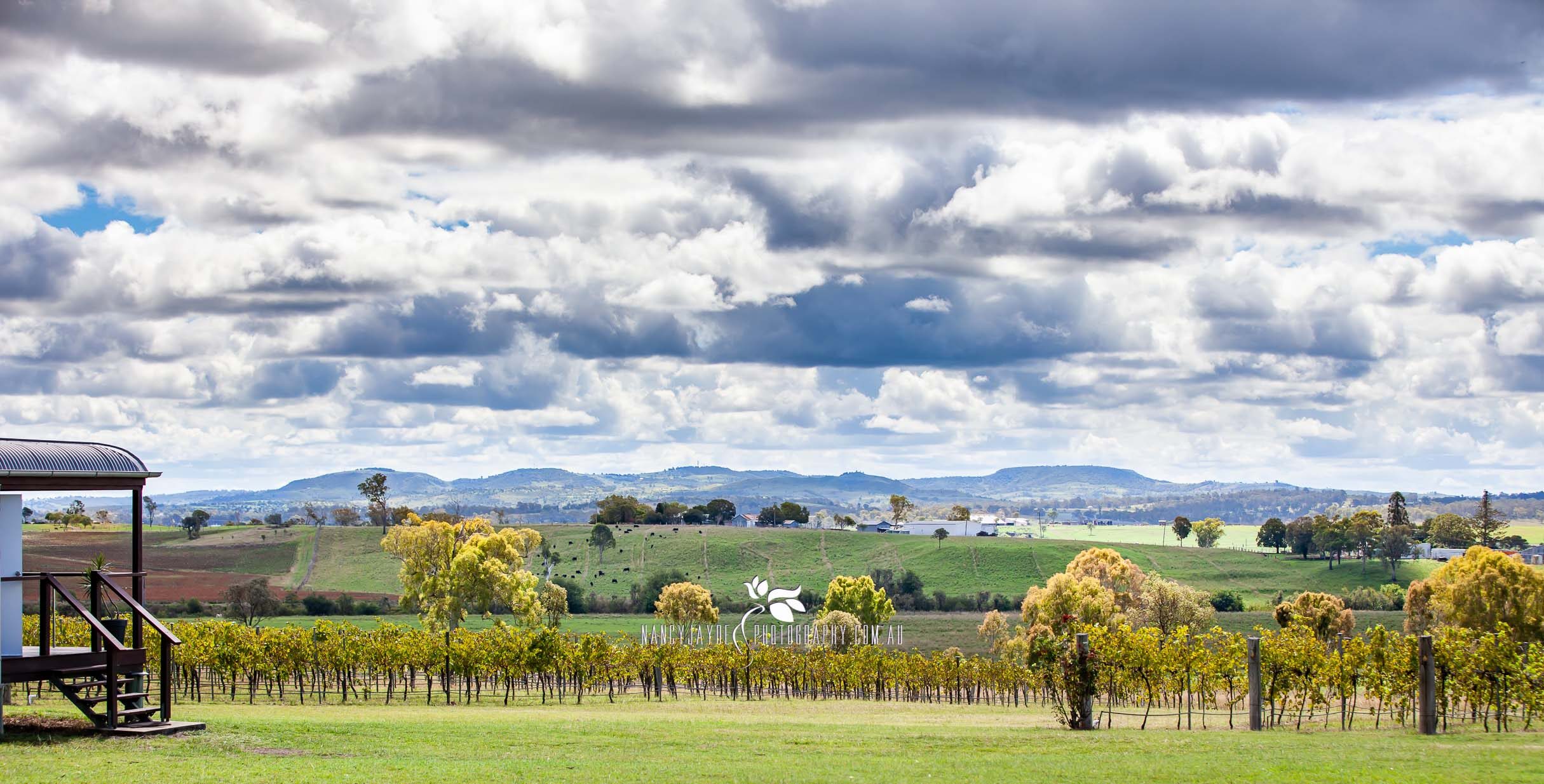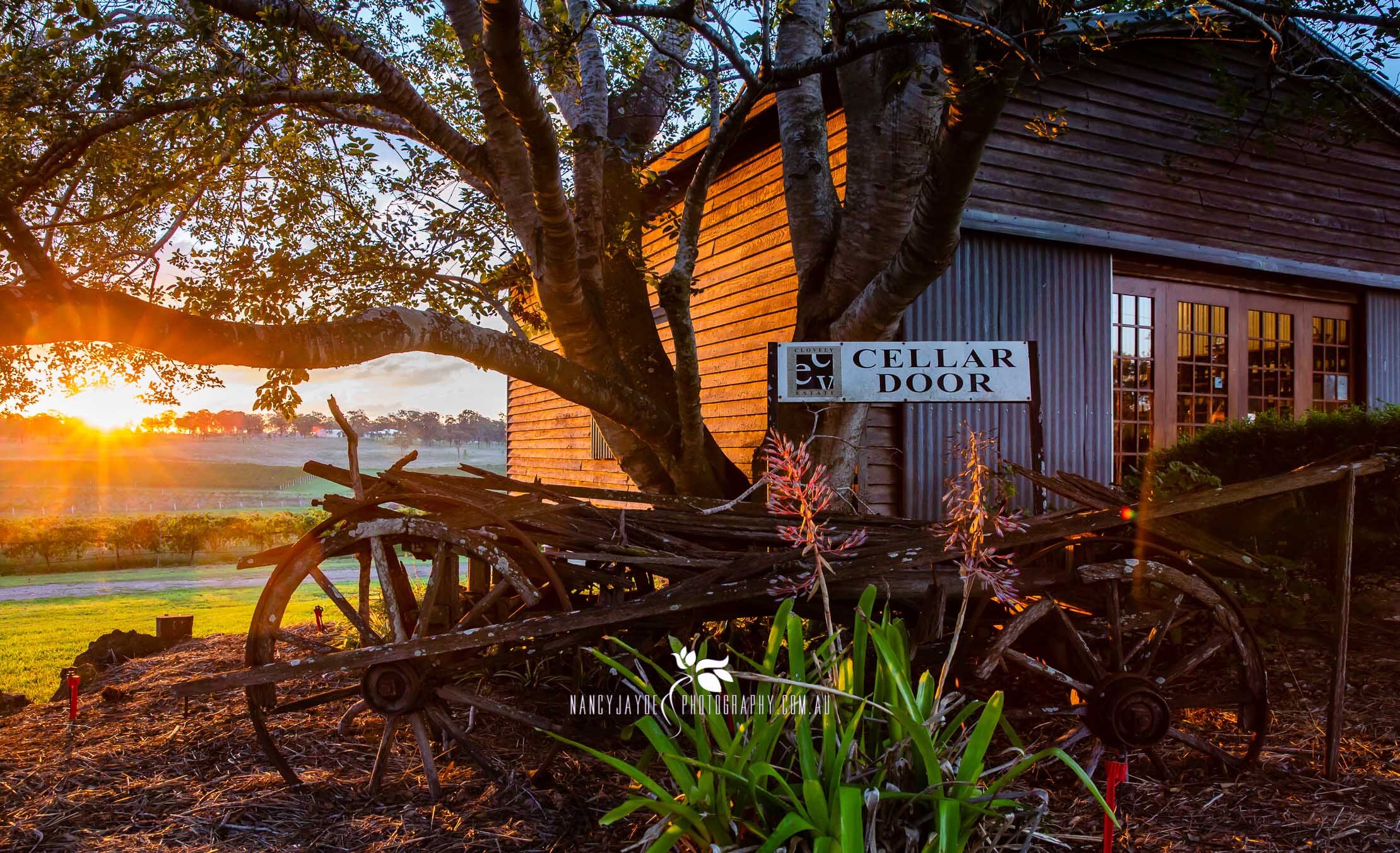Wine in the South Burnett
Wine in the South Burnett
Explore some great food and wine!
Find A Winery
Explore some amazing wineries throughout the region, and truly find a hidden gem amongst the vines.
Find a Winery Tour
Discover the best of the South Burnett Wine Region with a wine tour.
Harvesting the Grape
Learn all about harvesting from the winemaker.
Pioneering a great drop: The South Burnett wine industry
After nearly 30 years of exciting growth, the South Burnett Wine industry might be one of Australia’s younger collections of vineyards but the creation of wine has played a long and rich part of the region’s history with local production as old as the European settlement itself. Some of the vines planted at Boondooma Homestead date back as far as 1855, with wine-growing brought to the region by the early German settlers and with their knowledge, skills and love of wine it was only a matter of time before full commercial production would flourish.
In the early 1990s with the emergence of the South Burnett as an idyllic tourism region and the surge in gourmet travellers, it was time for the local wine to shine. In 1992 the first of the modern-day commercial vineyards were planted on the Booie range near Kingaroy and at Moffatdale near Murgon. The first commercial crush was a small one-tonne parcel of Cabernet Sauvignon produced at Crane Wines, just outside of Kingaroy. The expectation for the South Burnett was so great investment dollars often hard to attract flowed into the region and in 1995 Queensland’s largest vineyard was planted at Moffatdale, and the industry boomed. The wine industry in the South Burnett was in full steam, and wineries dotted the length and breadth of the South Burnett. The warm summer days and cool autumn evenings are perfect for the production of premium quality grapes. Combined with the high-altitude red soils of the Booie Range and the fertile valley floor at Moffatdale and this must surely have been a region which has waited centuries to nurture their valuable crops and nurture they did, offering up the fruit which would produce some of Australia’s finest boutique wines.
In the early years the South Burnett saw plantings of traditional varieties such as Shiraz, Chardonnay, Cabernet Sauvignon and Semillon but by 2009 the South Burnett began to recognise the region’s climatic similarities with the Mediterranean and varieties new to the scene such as Alberino, Sangiovese and Fiano appeared on the scene, all looking very promising, but it was an unassuming variety from Portugal called Verdelho that put the South Burnett on the worldwide wine map. With the region now producing some of the best Verdelho in the world, the South Burnett is home to a host of prestigious trophies and awards and the faith placed in the industry, with more than 20 vineyards planted and a host of outstanding cellar doors.
From our early pioneers who carried a vine cutting wrapped in the sand all the way from the old country through to the million-dollar investments present in the region today, it is fair to say the South Burnett is truly in the grip of the grape. In an industry that can take a lifetime to build, the South Burnett wine industry has come a long way and if the passion and dedication of our vintners is anything to go by, the future certainly has plenty of blue skies and full glasses ahead.
In a nutshell
The first commercial vines were planted in 1992. Now 800acres planted under vines, with 800 tonnes crushed and 550,000L produced.
Harvesting the Grape & Making the Wine
The most exciting time in any wine region is Harvest time or more correctly known as Vintage. For the South Burnett vintage can begin as early as Christmas eve for Verdelho and generally finishes mid-February with red varieties like Shiraz, Cabernet Sauvignon etc. Vintage is exciting but also nerve wracking as winemakers, like expectant fathers pacing the halls of the maternity ward watching for any sign of trouble, whilst the growers play the role of ward nurse telling the winemakers to stay away and to just wait. The conflict comes between the grape grower who just wants the fruit picked and crushed so further risk is avoided and his or her job is done for the year, and the winemaker who knows that only the ripest ,cleanest grapes picked at the perfect time will produce the best wine. Always remember good wine is made in the vineyard.
What makes a perfect grape is different for each variety and is definitely a balancing act between time and weather. In a dryer season you can allow the fruit to ripen happily on the vine, but in a wet season the grower must try to get the fruit as ripe as possible whilst avoiding rainfall events which will dilute the natural sugars and flavours and risk disease onset and potentially the total loss of the crop.
Around the end of November, the grapes will start to change colour and begin the transition from the vibrant green they were as flowers into the golden hues of the whites and deep purple of the reds; this process is called varaison. By mid-December the colour transition is complete and the grower will begin the task of testing the Baume or sugar level of the grapes. This is a process of collecting 1 berry from each of 100 bunches, crushing them in a container and then testing the juice using a specific gravity hydrometer. The process will start with weekly testing and as the ripeness and sugar levels rise it will move to finally daily testing until the sugar is at perfect levels. The rough calculation is 1 Baume = 18 grams per litre of sugar and will result in 1% of alcohol in the final wine.
The winemaker will aim for somewhere between 11 and 13 Baume for white wines and 12 to 14 for reds. When the fruit reaches its optimal ripeness, the actual harvest begins.
Harvesting in most regions has seen the replacement of hand pickers with machines and now generally occurs at night. The white grapes will be harvested first taking full advantage of the cool night air, often commencing when the night time minimum temperature has been reached and is finished as the dawn approaches, ensuring that the fruit remains cold during the entire process. Once picked the fruit is delivered swiftly to the anxious winemaker. The winemaker knows that their role is to crush and press the fruit, releasing the juice and getting it into a tank with refrigeration immediately, knowing that every minute wasted has an effect on final wine quality. As the fruit enters the crush the winemaker will introduce acid, enzymes and additions if and as required. The juice will be chilled rapidly in tank reaching the optimal temperature of 6 degrees.
This cooling will assist the pulp to settle to the bottom of the tank, leaving cold clear juice on top. The juice will be carefully racked off into a fresh tank leaving the pulp behind as waste. After 24 hours the juice will be allowed to return to 14 degrees, a temperature more comfortable for the addition of the yeast. The fermentation begins and the juice is carefully monitored keeping the temperature between 14 and 18 degrees for the fortnight or so required for the completion of ferment. Then it’s time for the Winemaker and the grape grower to sit down for a well-earned beer. Back to top

Nuova Scuola
At Nuova Scuola we believe it is time to throw aside tradition and let go of the over thrashed varieties that fill the rows of bottle shops everywhere.
It's time to embrace a new way of thinking about wine! We think it is about time more of us get our lips around some locally grown versions of a few of the fantastic old world varieties that the rest of the world has been clued into since ancient times but we have forgotten!

Moffatdale Ridge
Home to the region’s most awarded Verdelho as well as a variety of excellent wines and a wide range of liqueurs and fortified wines, Moffatdale Ridge also offers visitors a chance to enjoy lunch overlooking the beautiful Barambah Creek at the wineries own D’Vine Restaurant.

Clovely Estate
Clovely Estate’s vineyards and olive groves flourish on the sun-kissed hills of the South Burnett, forming the heart of the Clovely experience. From this rich landscape come award-winning wines, locally grown olives, premium cold-pressed olive oils, and creative gins—perfect for inspiring memorable feasts, rustic dinners, and warm gatherings with friends.

South Burnett Wine Industy Association
The South Burnett Wine Region, nestled in Queensland's picturesque countryside, is home to a collection of passionate, small-scale winemakers dedicated to producing award-winning wines. Stretching from the Barambah Valley to the Booie Ranges and Kingaroy, the region offers a diverse range of varietals, including Semillon, Verdelho, Viognier, Sangiovese, Shiraz, and Saperavi, all crafted to complement Queensland's relaxed lifestyle. Visitors can enjoy intimate cellar door experiences, often guided by the very hands that nurtured the vines, and savor local produce paired with vibrant wines. Just a few hours' drive from Brisbane, Toowoomba, and the coast, the South Burnett Wine Region invites you to uncork the magic and discover the stories in every bottle.

Dusty Hill Vineyard
Overlooking picturesque Lake Barambah, Dusty Hill is one of the region’s first established wineries and is highly regarded as an outstanding venue for food and wine as well as boutique accommodation, with their gorgeous cottages available amongst the vineyards.
Why not experience the picturesque South Burnett Wine Region for yourself, and try a guided tour.
South Burnett Wine Tours
www.southburnettwinetours.com.au
Personalised Wine tours throughout the South Burnett region.
Small groups, special occasions.


